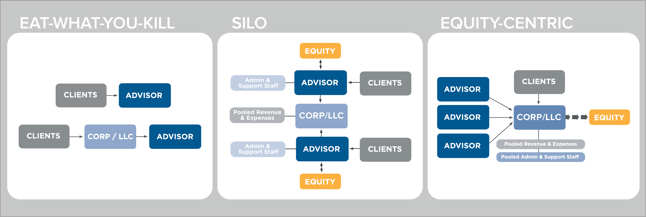Blog
Ship vs. Life Raft - What Are YOU Building?


Picture a bright orange life raft floating on a dark blue, storm-tossed ocean. In this durable, well-built, small craft sits an independent financial advisor. Our advisor has a paddle for propulsion – the means by which to move the raft to safer or more prosperous waters. Our advisor has the means to collect and store rain water for drinking, and fishing tackle to bring in food for survival – the craft literally is floating on a sea of food and fuel to sustain and propel its lone occupant. Our advisor also has a compass for navigation to guide forward progress along a chosen route.
In terms of organizational structure, this sole proprietorship model is a common starting point for many advisors. With this model a single advisor is compensated on an “eat-what-you-kill,” basis–the clients are under his or her service; he or she receives 100% of the revenue to pay their own individual expenses, and takes 100% of the profits (if any) that remain.
To its credit, this basic production-based, or advisor-driven, model is extremely adaptable and simple to establish and operate. And while it may work for a single advisor office where there are only business expenses and compensation for one, it should not be mistaken for a building block for larger, more sustainable business models. Unfortunately, it often is.
Over time, though the sea is vast, there are many financial advisors and our advisor encounters other life rafts and other peers. Most of the time, they just pass by and co-exist, easily and effortlessly competing for the same food supplies without much thought or concern. But in time, when the skies grow dark and the seas inevitably become more challenging and dangerous, behaviors tend to change. Instead of passing by each other, advisors come together and form a group. Under the right circumstances, they’ll lash their life-rafts together for safety and support and form a flotilla of three or four, each sitting in a separate craft, but inextricably linked together for the duration of the event.
Attempting to scale the sole-proprietor model and preserving an “eat-what-you-kill” structure, even as the entity begins to operate with more than one advisor, will lead to problems.
During their time together, our financial advisors can explore various opportunities. Synergies may develop from the group as the paddles are placed in the hands of the strongest advisors, whose task it will be to propel the group to safety. The advisor best qualified to lead and navigate will take the compass and direct the group with a single vision and set of actions. And the advisor best suited for “hunting and gathering” will be in charge of collecting water and catching fish to sustain the efforts of his or her crewmates – each doing what they do best, contributing to the success of the group. But it is just as likely that each independent advisor continues to function as a separate unit, each “eating what they kill” and each reserving the right to cut the ropes and paddle off at any time and in a direction of their own choosing.
These silo-based models may operate under one common business name and entity structure to the advisors’ clients and the public, but at the core the business model, the corporation or LLC, has little to no value because the only thing attached to the entity are the expenses. The equity–where the value really lies–is attached to each advisor individually and is solely contingent on his or her own exclusive clientele.
One of the biggest mistakes that financial advisors continue to make is to view this group of life rafts as the pinnacle of business growth and organization, or even as the goal. The mistake is to think of this loose assembly of individuals and producers as a “ship” when in fact it is nothing more than a flotilla, quick and easy to assemble, and equally quick and easy to disassemble.
In reality, each advisor is operating–and receiving revenue from–his or her own “book of business” separate from the "books" of the other advisors in the same business. These clients belong to the advisor, not the entity. An advisor could leave the entity and take all of their clients with them at any time. This makes for an unstable business, undesirable to the market, and therefore holding minimal value.
A ship, though, is a sturdy mass manned by a skilled crew of advisors. Each contributes from their strengths and each share in the bounty and safety of the vessel as a whole on the unpredictable seas.
Unlike the flotilla of seafarers, who have lashed themselves together, the ship's structural integrity and stability are not threatened by the departure of a single advisor. Nothing about the ship itself has been altered, merely the individuals running it. The ship remains strong and intact.
The most valuable, sustainable, and enduring business models in the industry are “Equity-Centric Ensembles.” A properly structured Equity-Centric model relies on a strong, centralized entity structure which collects all revenue and in turn pays out compensation for work performed and takes care of operating expenses. Any equity stake held by an individual is granted by the entity in exchange for their investment.
The entity allocates profit distributions in direct relation to this investment as part of its compensation structure. Profit distributions are both a return on current investment and a vehicle to fuel continued investment, and with it fuel the growth of the entity, including its profit and value.
It's an upward cycle driving the value of the business higher.

![Destabilizing Value with Revenue Sharing [Article]](https://no-cache.hubspot.com/cta/default/475699/5d758ab6-d896-485c-8f1c-c0c7ef8d0593.png)